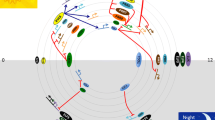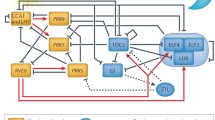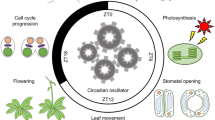Abstract
Growth and development of plants is controlled by external and internal signals. Key internal signals are those generated by hormones and the circadian clock. We highlight interactions between the circadian clock and hormonal signalling networks in regulating the physiology and growth of plants. Microarray analysis has shown that a significant proportion of transcripts involved in hormonal metabolism, catabolism, perception and signalling are also regulated by the circadian clock. In particular, there are interactions between the clock and abscisic acid, auxin, cytokinin and ethylene signalling. We discuss the role of circadian modulation (‘gating’) of hormonal signals in preventing temporally inappropriate responses. A consideration of the daily changes in physiology provides evidence that circadian gating of hormonal signalling couples the rhythmic regulation of carbon and water utilisation to rhythmic patterns of growth.



Similar content being viewed by others
References
Abeles FB, Morgan PW, Saltveit ME Jr (1992) Ethylene in plant biology, 2nd edn. Academic Press, San Diego
Allen GJ, Muir SR, Sanders D (1995) Release of Ca2+ from individual plant vacuoles by both InsP3 and cyclic ADP-ribose. Science 268:735–737. doi:10.1126/science.7732384
Asher G, Gatfield D, Stratmann M, Reinke H, Dibner C, Kreppel F et al (2008) SIRT1 regulates circadian clock gene expression through PER2 deacetylation. Cell 134:317–328. doi:10.1016/j.cell.2008.06.050
Correia MJ, Pereira JS, Chaves MM, Rodrigues ML, Pacheco CA (1995) ABA xylem concentrations determine maximum daily leaf conductance in field-grown Vitis vinifera L. plants. Plant Cell Environ 18:511–521. doi:10.1111/j.1365-3040.1995.tb00551.x
Covington MF, Harmer SL (2007) The circadian clock regulates auxin signaling and responses in Arabidopsis. PLoS Biol 5(8):e222. doi:10.1371/journal.pbio.0050222
Covington MF, Panda S, Liu XL, Strayer CA, Wagner DR, Kay SA (2001) ELF3 modulates resetting of the circadian clock in Arabidopsis. Plant Cell 13:1305–1315
Daniel X, Sugano S, Tobin EM (2004) CK2 phosphorylation of CCA1 is necessary for its circadian oscillator function in Arabidopsis. Proc Natl Acad Sci USA 101:3292–3297. doi:10.1073/pnas.0400163101
Dodd AN, Salathia N, Hall A, Kévei E, Tóth R, Nagy F et al (2005) Plant circadian clocks increase photosynthesis, growth, survival, and competitive advantage. Science 309:630–633. doi:10.1126/science.1115581
Dodd AN, Jakobsen MK, Baker AJ, Telzerow A, Hou S-W, Laplaze L et al (2006) Time of day modulates low-temperature Ca2+ signals in Arabidopsis. Plant J 48:962–973. doi:10.1111/j.1365-313X.2006.02933.x
Dodd AN, Gardner MJ, Hotta CT, Hubbard KE, Dalchau N, Love J et al (2007) The Arabidopsis circadian clock incorporates a cADPR-based feedback loop. Science 318:1789–1792. doi:10.1126/science.1146757
Dowson-Day MJ, Millar AJ (1999) Circadian dysfunction causes aberrant hypocotyl elongation patterns in Arabidopsis. Plant J 17:63–71. doi:10.1046/j.1365-313X.1999.00353.x
Edwards KD, Anderson PE, Hall A, Salathia NS, Locke JC, Lynn JR et al (2006) FLOWERING LOCUS C mediates natural variation in the high-temperature response of the Arabidopsis circadian clock. Plant Cell 18:639–650. doi:10.1105/tpc.105.038315
Finkelstein RR, Rock CD (2002) Abscisic acid biosynthesis and response. In: Somerville CR, Meyerowitz EM (eds) The arabidopsis book. American Society of Plant Biologists, Rockville, pp 1–48
Fowler SG, Thomashow MF (2002) Arabidopsis transcriptome profiling indicates that multiple regulatory pathways are activated during cold acclimation in addition to the CBF cold response pathway. Plant Cell 14:1675–1690. doi:10.1105/tpc.003483
Fowler SG, Cook D, Thomashow MF (2005) Low temperature induction of Arabidopsis CBF1, 2 and 3 is gated by the circadian clock. Plant Physiol 137:961–968. doi:10.1104/pp.104.058354
Gardner MJ, Hubbard KE, Hotta CT, Dodd AN, Webb AAR (2006) How plants tell the time. Biochem J 397:15–24. doi:10.1042/BJ20060484
Gibon Y, Bläsing OE, Palacios-Rojas N, Pankovic D, Hendriks JHM, Fisahn J et al (2004) Adjustment of diurnal starch turnover to short days: depletion of sugar during the night leads to a temporary inhibition of carbohydrate utilization, accumulation of sugars and post-translational activation of ADP-glucose pyrophosphorylase in the following light period. Plant J 39:847–862. doi:10.1111/j.1365-313X.2004.02173.x
Green RM, Tingay S, Wang ZY, Tobin EM (2002) Circadian rhythms confer a higher level of fitness to Arabidopsis plants. Plant Physiol 129:576–584. doi:10.1104/pp.004374
Hamilton DA, Davies PJ (1988) Mechanism of export of organic material from the developing fruits of pea. Plant Physiol 86:956–959
Han L, Mason M, Risseeuw EP, Crosby WL, Somers DE (2004) Formation of an SCFZTL complex is required for proper regulation of circadian timing. Plant J 40:291–301. doi:10.1111/j.1365-313X.2004.02207.x
Hanano S, Domagalska MA, Nagy F, Davis SJ (2006) Multiple phytohormones influence distinct parameters of the plant circadian clock. Genes Cells 11:1381–1392. doi:10.1111/j.1365-2443.2006.01026.x
Harmer SL, Hogenesch JB, Straume M, Chang HS, Han B, Zhu T et al (2000) Orchestrated transcription of key pathways in Arabidopsis by the circadian clock. Science 290:2110–2113. doi:10.1126/science.290.5499.2110
Hazen SP, Schultz TF, Pruneda-Paz JL, Borevitz JO, Ecker JR, Kay SA (2005) LUX ARRHYTHMO encodes a Myb domain protein essential for circadian rhythms. Proc Natl Acad Sci USA 102:10387–10392. doi:10.1073/pnas.0503029102
Hotta CT, Gardner MJ, Hubbard KE, Baek SJ, Dalchau N, Suhita D et al (2007) Modulation of environmental responses of plants by circadian clocks. Plant Cell Environ 30:333–349. doi:10.1111/j.1365-3040.2006.01627.x
Hunt L, Lerner F, Ziegler M (2004) NAD—new roles in signalling and gene regulation in plants. New Phytol 163:31–44. doi:10.1111/j.1469-8137.2004.01087.x
Ikeda M, Sugiyama T, Wallace CS, Gompf HS, Yoshioka T, Miyawaki A et al (2003) Circadian dynamics of circadian and nuclear Ca2+ in single suprachiasmatic nucleus neurones. Neuron 38:253–263. doi:10.1016/S0896-6273(03)00164-8
Imaizumi T, Kay SA (2006) Photoperiodic control of flowering: not only by coincidence. Trends Plant Sci 11:550–558. doi:10.1016/j.tplants.2006.09.004
Johnson CH, Knight MR, Kondo T, Masson P, Sedbrook J, Haley A et al (1995) Circadian oscillations of cytosolic and chloroplastic free calcium in plants. Science 269:1863–1865. doi:10.1126/science.7569925
Jouve L, Gaspar T, Kevers C, Greppin H, Degli Agosti R (1999) Involvement of indole-3-acetic acid in the circadian growth of the first internode of Arabidopsis. Planta 209:136–142. doi:10.1007/s004250050615
Kim WY, Fujiwara S, Suh SS, Kim J, Kim Y, Han L et al (2007) ZEITLUPE is a circadian photoreceptor stabilized by GIGANTEA in blue light. Nature 449:356–360. doi:10.1038/nature06132
Kreps JA, Wu Y, Chang HS, Zhu T, Wang X, Harper JF (2002) Transcriptome changes for Arabidopsis in response to salt, osmotic, and cold stress. Plant Physiol 130:2129–2141. doi:10.1104/pp.008532
Lebaudy A, Vavasseur A, Hosy E, Dreyer I, Leonhardt N, Thibaud JB et al (2008) Plant adaptation to fluctuating environment and biomass production are strongly dependent on guard cell potassium channels. Proc Natl Acad Sci USA 105:5271–5276. doi:10.1073/pnas.0709732105
Lee HC (2002) Cyclic ADP-ribose and NAAPD: structures, metabolism and functions. Kluwer Academic Publishers, Boston
León P, Sheen J (2003) Sugar and hormone connections. Trends Plant Sci 8:110–116. doi:10.1016/S1360-1385(03)00011-6
Leyser O (2005) Auxin distribution and plant pattern formation: how many angels can dance on the point of PIN? Cell 121:819–822. doi:10.1016/j.cell.2005.06.005
Liu Q, Kasuga M, Sakuma Y, Abe H, Miura S, Yamaguchi-Shinozaki K et al (1998) Two transcription factors, DREB1 and DREB2, with an EREBP/AP2 DNA binding domain separate two cellular signal transduction pathways in drought- and low-temperature-responsive gene expression, respectively, in Arabidopsis. Plant Cell 10:1391–1406
Locke JCW, Southern MM, Kozma-Bognár L, Hibberd V, Brown PE, Turner MS et al (2005) Extension of a genetic network model by iterative experimentation and mathematical analysis. Mol Syst Biol 1:1744–4292. doi:10.1038/msb4100018
Locke JCW, Kozma-Bognár L, Gould PD, Fehér B, Kevei E, Nagy F et al (2006) Experimental validation of a predicted feedback loop in the multi-oscillator clock of Arabidopsis thaliana. Mol Syst Biol 2:59. doi:10.1038/msb4100102
Maruyama K, Sakuma Y, Kasuga M, Ito Y, Seki M, Goda H et al (2004) Identification of cold-inducible downstream genes of the Arabidopsis DREB1A/CBF3 transcriptional factor using two microarray systems. Plant J 38:982–993. doi:10.1111/j.1365-313X.2004.02100.x
Más P, Kim WY, Somers DE, Kay SA (2003) Targeted degradation of TOC1 by ZTL modulates circadian function in Arabidopsis thaliana. Nature 426:567–570. doi:10.1038/nature02163
McWatters HG, Bastow RM, Hall A, Millar AJ (2000) The ELF3 zeitnehmer regulates light signalling to the circadian clock. Nature 408:716–720. doi:10.1038/35047079
Michael TP, Mockler TC, Breton G, McEntee C, Byer A, Trout JD et al (2008) Network discovery pipeline elucidates conserved time-of-day specific cis-regulatory modules. PLoS Genet 4(2):e14. doi:10.1371/journal.pgen.0040014
Millar AJ (2004) Input signals to the plant circadian clock. J Exp Bot 55:277–283. doi:10.1093/jxb/erh034
Mizuno T, Yamashino T (2008) Comparative transcriptome of diurnally oscillating genes and hormone-responsive genes in Arabidopsis thaliana: insight into circadian clock-controlled daily responses to common ambient stresses in plants. Plant Cell Physiol 49:481–487. doi:10.1093/pcp/pcn008
Moore B, Zhou L, Rolland F, Hall Q, Cheng WH, Liu YX et al (2003) Role of the Arabidopsis glucose sensor HXK1 in nutrient, light and hormonal signaling. Science 300:332–336. doi:10.1126/science.1080585
Navazio L, Mariani P, Sanders D (2001) Mobilization of Ca2+ by cyclic ADP-ribose from the endoplasmic reticulum of cauliflower florets. Plant Physiol 125:2129–2138. doi:10.1104/pp.125.4.2129
Nomura H, Komori T, Kobori M, Nakahira Y, Shiina T (2008) Evidence for chloroplast control of external Ca2+-induced cytosolic Ca2+ transients and stomatal closure. Plant J 53:988–998. doi:10.1111/j.1365-313X.2007.03390.x
Nozue K, Covington MF, Duek PD, Lorrain S, Fankhauser C, Harmer SL et al (2007) Rhythmic growth explained by coincidence between internal and external cues. Nature 448:358–361. doi:10.1038/nature05946
Panda S, Poirier GG, Kay SA (2002) tej Defines a role for poly(ADP-ribosyl)ation in establishing period length of the arabidopsis circadian oscillator. Dev Cell 3:51–61. doi:10.1016/S1534-5807(02)00200-9
Para A, Farré EM, Imaizumi T, Pruneda-Paz JL, Harmon FG, Kay SA (2007) PRR3 is a vascular regulator of TOC1 stability in the Arabidopsis circadian clock. Plant Cell 19:3462–3473. doi:10.1105/tpc.107.054775
Rolland F, Baena-Gonzalez E, Sheen J (2006) Sugar sensing and signaling in plants: conserved and novel mechanisms. Annu Rev Plant Biol 57:675–709. doi:10.1146/annurev.arplant.57.032905.105441
Sai J, Johnson CH (2002) Dark-stimulated calcium ion fluxes in the chloroplast stroma and cytosol. Plant Cell 14:1279–1291. doi:10.1105/tpc.000653
Sakakibara H (2006) CYTOKININS: activity, biosynthesis, and translocation. Annu Rev Plant Biol 57:431–449. doi:10.1146/annurev.arplant.57.032905.105231
Salomé PA, McClung CR (2005) What makes the Arabidopsis clock tick on time? A review on entrainment. Plant Cell Environ 28:21–38. doi:10.1111/j.1365-3040.2004.01261.x
Salomé PA, To JPC, Kieber JJ, McClung CR (2006) Arabidopsis response regulators ARR3 and ARR4 play cytokinin-independent roles in the control of circadian period. Plant Cell 18:55–69. doi:10.1105/tpc.105.037994
Salter MG, Franklin KA, Whitelam GC (2003) Gating of the rapid shade-avoidance response by the circadian clock in plants. Nature 426:680–683. doi:10.1038/nature02174
Sethi JK, Empson RM, Galione A (1996) Nicotinamide inhibits cyclic ADP-ribose-mediated calcium signalling in sea urchin eggs. Biochem J 319:613–617
Smith AM, Stitt M (2007) Coordination of carbon supply and plant growth. Plant Cell Environ 30:1126–1149. doi:10.1111/j.1365-3040.2007.01708.x
Smith SM, Fulton DC, Chia T, Thorneycroft D, Chapple A, Dunstan H et al (2004) Diurnal changes in the transcriptome encoding enzymes of starch metabolism provide evidence for both transcriptional and posttranscriptional regulation of starch metabolism in Arabidopsis leaves. Plant Physiol 136:2687–2699. doi:10.1104/pp.104.044347
Snaith PJ, Mansfield TA (1985) Responses of the stomata to IAA and fusicoccin at the opposite phases of an entrained rhythm. J Exp Bot 36:937–944. doi:10.1093/jxb/36.6.937
Somers DE, Webb AAR, Pearson M, Kay SA (1998) The short-period mutant, toc1-1, alters circadian clock regulation of multiple outputs throughout development in Arabidopsis thaliana. Development 125:485–494
Tang RH, Han S, Zheng H, Cook CW, Choi CS, Woerner TE et al (2007) Coupling diurnal cytosolic Ca2+ oscillations to the CAS-IP3 pathway in Arabidopsis. Science 315:1423–1426. doi:10.1126/science.1134457
Thain SC, Vandenbussche F, Laarhoven LJ, Dowson-Day MJ, Wang ZY, Tobin EM et al (2004) Circadian rhythms of ethylene emission in Arabidopsis. Plant Physiol 136:3751–3761. doi:10.1104/pp.104.042523
Thomas TH, Hare PD, Van Staden J (1997) Phytochrome and cytokinin responses. Plant Growth Regul 23:105–122. doi:10.1023/A:1005906609158
Viswanathan C, Zhu JK (2002) Molecular genetic analysis of cold-regulated gene transcription. Philos Trans R Soc Lond B Biol Sci 357:877–886. doi:10.1098/rstb.2002.1076
Vogel JT, Zarka DG, Van Buskirk HA, Fowler SG, Thomashow MF (2005) Roles of the CBF2 and ZAT12 transcription factors in configuring the low temperature transcriptome of Arabidopsis. Plant J 41:195–211. doi:10.1111/j.1365-313X.2004.02288.x
Webb AAR (1998) Stomatal rhythms. In: Lumsden PJ, Millar AJ (eds) Biological rhythms and photoperiodism in plants. Bios Scientific Publications, Oxford, pp 66–79
Went FW, Thimann KV (1937) Phytohormones. The Macmillan Company, New York, p 294
Wu Y, Sanchez JP, Lopez-Molina L, Himmelbach A, Grill E, Chua NH (2003) The abi1-1 mutation blocks ABA signalling downstream of cADPR action. Plant J 34:307–315. doi:10.1046/j.1365-313X.2003.01721.x
Xu X, Hotta CT, Dodd AN, Love J, Sharrock R, Lee YW et al (2007) Distinct light and clock modulation of cytosolic free Ca2+ oscillations and rhythmic CHLOROPHYLL A/B BINDING PROTEIN2 promoter activity in Arabidopsis. Plant Cell 19:3474–3490. doi:10.1105/tpc.106.046011
Zeilinger MN, Farré EM, Taylor SR, Kay SA, Doyle FJ 3rd (2006) A novel computational model of the circadian clock in Arabidopsis that incorporates PRR7 and PRR9. Mol Syst Biol 2:58. doi:10.1038/msb4100101
Zheng B, Deng Y, Mu J, Ji Z, Xiang T, Niu Q-W et al (2006) Cytokinin affects circadian-clock oscillation in a phytochrome B- and Arabidopsis response regulator 4-dependent manner. Physiol Plant 127:277–292. doi:10.1111/j.1399-3054.2006.00660.x
Acknowledgements
The authors thank AN Dodd for critical reading. Research is funded by the Biotechnology and Biological Sciences Research Council (UK), Engineering and Physical Sciences Research Council (UK), the Royal Society of London, the Isaac Newton Trust and Corpus Christi College Cambridge.
Author information
Authors and Affiliations
Corresponding author
Rights and permissions
About this article
Cite this article
Robertson, F.C., Skeffington, A.W., Gardner, M.J. et al. Interactions between circadian and hormonal signalling in plants. Plant Mol Biol 69, 419–427 (2009). https://doi.org/10.1007/s11103-008-9407-4
Received:
Accepted:
Published:
Issue Date:
DOI: https://doi.org/10.1007/s11103-008-9407-4




